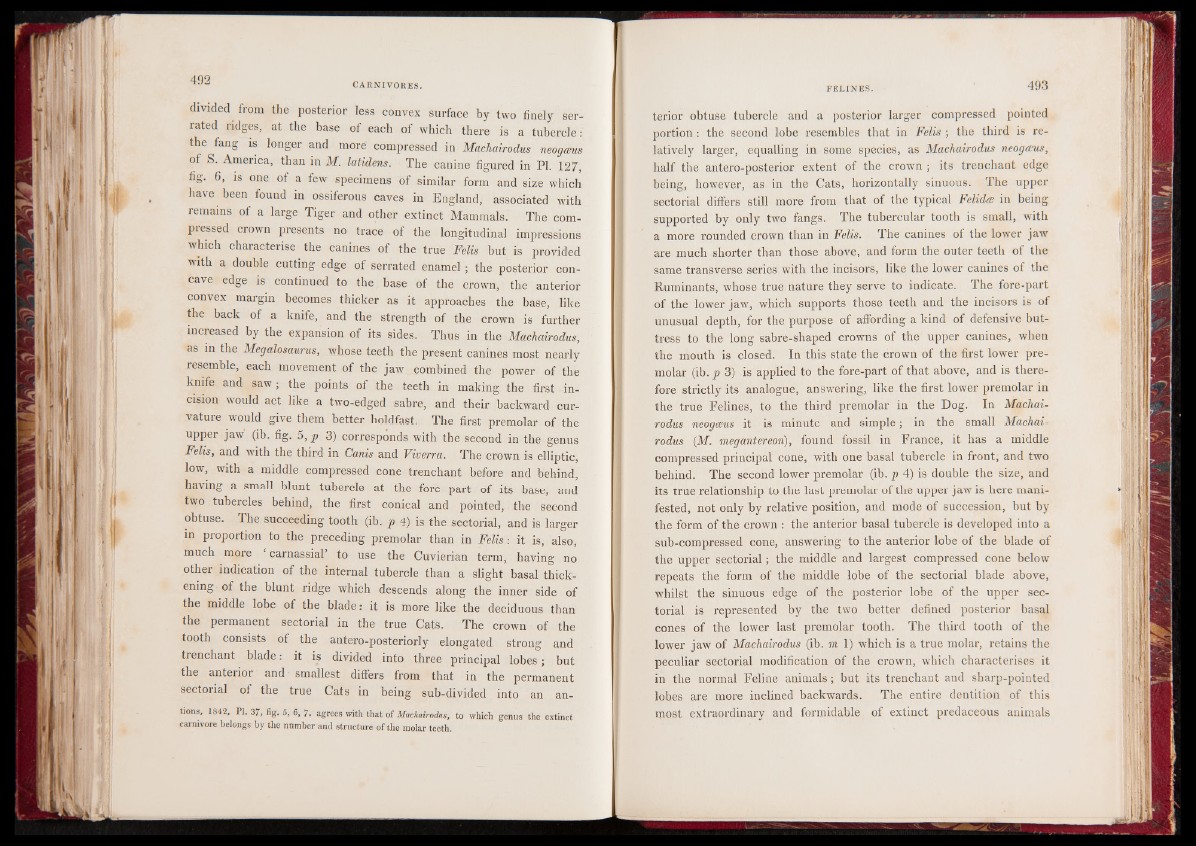
divided from the posterior less convex surface by two finely serrated
ridges, at the base of each of which there is a tubercle:
the fang is longer and more compressed in Machairodus neogceus
of S. America, than in M. latidens. The canine figured in PI. 127,
fig. 6, is one of a few specimens of similar form and size which
have been found in ossiferous caves in England, associated with
remains of a large Tiger and other extinct Mammals. The compressed
crown presents no trace of the longitudinal impressions
which characterise the canines of the true Felis but is provided
with a double cutting edge of serrated enamel; the posterior concave
edge is continued to the base of the crown, the anterior
convex margin becomes thicker as it approaches the base, like
the back of a knife, and the strength of the crown is further
increased by the expansion of its sides. Thus in the Machairodus,
as in the Megalosaurus, whose teeth the present canines most nearly
resemble, each movement of the jaw. combined the power of the
knife and saw; the points of the teeth in making the first incision
would act like a two-edged sabre, and their backward curvature
would give them better holdfast. The first premolar of the
upper jaw (ib. fig. 5, p 3) corresponds with the second in the genus
Felis, and with the third in Canis and Viverra. The crown is elliptic,
low, with a middle compressed cone trenchant before and behind,
having a small blunt tubercle at the fore part of its base, and
two tubercles behind, the first conical and pointed, the second
obtuse. The succeeding tooth (ib. p 4) is the sectorial, and is larger
in proportion to the preceding premolar than in Felis: it is, also,
much more ‘ carnassial’ to use the Cuvierian term, having no
other indication of the internal tubercle than a slight basal thickening
of the blunt ridge which descends along the inner side of
the middle lobe of the blade: it is more like the deciduous than
the permanent sectorial in the true Cats. The crown of the
tooth consists of the antero-posteriorly elongated strong and
trenchant blade | it is divided into three principal lobes; but
the anterior and smallest differs from that in the permanent
sectorial of the true Cats in being sub-divided into an antions,
1842, PI. 37, fig. 5, 6, 7. agrees with that of Machairodus, to which genus the extinct
carnivore belongs by the number and structure of the molar teeth.
terior obtuse tubercle and a posterior larger compressed pointed
portion j the second lobe resembles that in Felis ; the third is relatively
larger, equalling in some species, as Machairodus neogceus,
half the antero-posterior extent of the crown ; its trenchant edge
being, however, as in the Cats, horizontally sinuous. The upper
sectorial differs still more from that of the typical Felidce in being
supported by only two fangs. The tubercular tooth is small, with
a more rounded crown than in Felis. The canines of the lower jaw
are much shorter than those above, and form the outer teeth of the
same transverse series with the incisors, like the lower canines of the
Ruminants, whose true nature they serve to indicate. The fore-part
of the lower jaw, which supports those teeth and the incisors is of
unusual depth, for the purpose of affording a kind of defensive buttress
to the long sabre-shaped crowns of the upper canines, when
the mouth is closed. In this state the crown of the first lower premolar
(ib. p 3) is applied to the fore-part of that above, and is therefore
strictly its analogue, answering, like the first lower premolar in
the true Felines, to the third premolar in the Dog. In Machairodus
neogceus it is minute and simple; in the small Machairodus
(M. megantereori), found fossil in France, it has a middle
compressed principal cone, with one basal tubercle in front, and two
behind. The second lower premolar (ib. p 4) is double the size, and
its true relationship to the last premolar of the upper jaw is here manifested,
not only by relative position, and mode of succession, but by
the form of the crown : the anterior basal tubercle is developed into a
sub-compressed cone, answering to the anterior lobe of the blade of
the upper sectorial; the middle and largest compressed cone below
repeats the form of the middle lobe of the sectorial blade above,
whilst the sinuous edge of the posterior lobe of the upper sectorial
is represented by the two better defined posterior basal
cones of the lower last premolar tooth. The third tooth of the
lower jaw of Machairodus (ib. m 1) which is a true molar, retains the
peculiar sectorial modification of the crown, which characterises it
in the normal Feline animals; but its trenchant and sharp-pointed
lobes are more inclined backwards. The entire dentition of this
most extraordinary and formidable of extinct predaceous animals